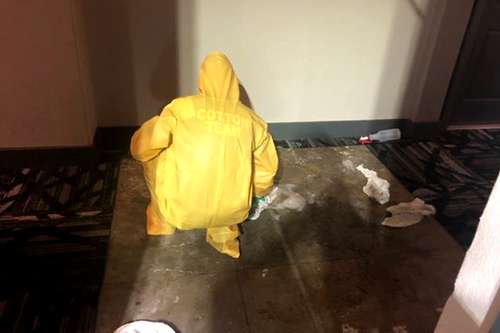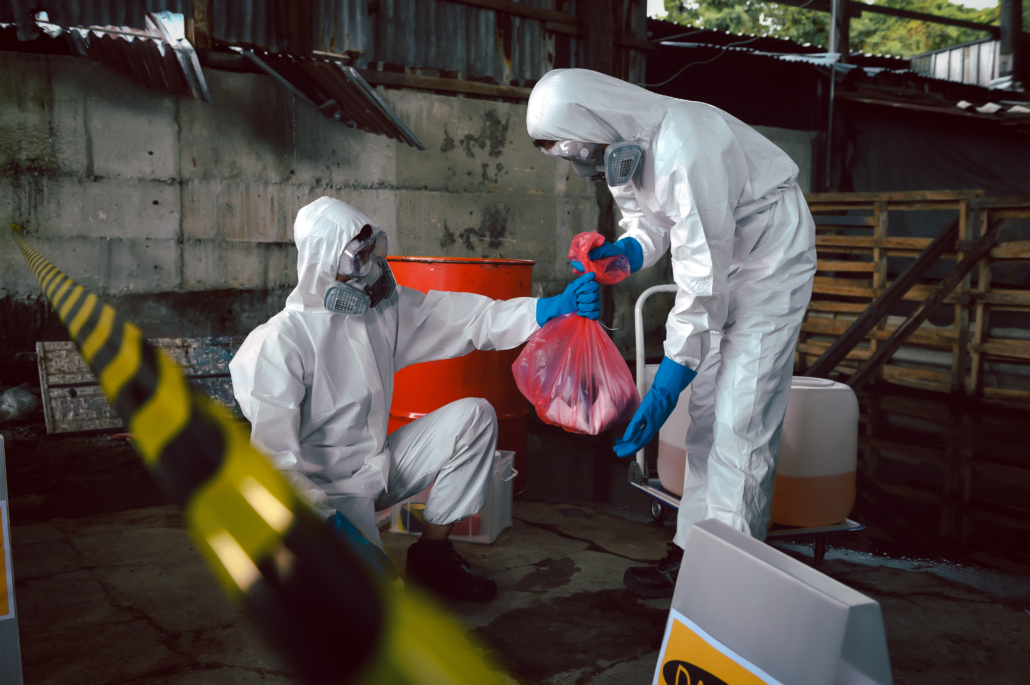Professional Biohazard Cleansing and Purification for Blood, Bodily Fluids, and Hazardous Materials
The potential wellness dangers linked with direct exposure to biohazards underscore the important need for thorough handling and extensive clean-up. As we browse the elaborate landscape of biohazard cleaning, comprehending the subtleties of guidelines, compliance, and the specific equipment at play becomes essential in making sure a detailed and safe purification procedure.
Health Risks of Biohazard Exposure
Exposure to biohazards poses significant health and wellness dangers that can result in extreme consequences for communities and individuals alike. Biohazards encompass a broad array of organic materials, including blood, physical fluids, mold, microorganisms, infections, and various other potentially contagious materials. When individuals come right into contact with these biohazards, whether via accidents, inappropriate handling, or environmental exposure, they face the danger of contracting major ailments or illness.
One of the main health dangers related to biohazard exposure is the transmission of infectious illness. Bloodborne pathogens such as HIV, liver disease B and C, and various germs can be present in biohazardous materials, posing a straight hazard to human health. Inhaling air-borne biohazards like mold spores or entering into call with infected surfaces can likewise bring about breathing concerns, allergies, and various other negative health effects.
Moreover, biohazard direct exposure can have lasting health implications, with some conditions manifesting years after the first get in touch with (Blood Cleanup). As a result, it is critical to focus on correct biohazard cleansing and decontamination to mitigate these wellness dangers and make certain the security of people and areas

Specialized Educating for Biohazard Cleanup
When it comes to taking care of biohazard cleanup efficiently and securely, specialized training plays a basic duty in making sure appropriate decontamination treatments are adhered to. Biohazard cleaning calls for particular expertise and abilities to successfully minimize risks connected with bloodborne virus, physical liquids, and hazardous products. Experts trained in biohazard cleaning go through rigorous instruction on just how to safely take care of, get rid of, and dispose of biohazardous materials to avoid contamination and direct exposure.
Specialized training for biohazard clean-up covers a variety of important topics, consisting of proper personal safety equipment (PPE) usage, bloodborne virus understanding, decontamination methods, and contaminated materials disposal methods. Individuals trained in biohazard clean-up are furnished with the essential competence to analyze contamination degrees, identify prospective risks, and carry out proper cleaning treatments in conformity with regulative criteria.
Continual training and education and learning are vital in the field of biohazard cleaning to remain upgraded on the most recent decontamination technologies, safety and security methods, and guidelines. By purchasing specialized training, biohazard clean-up professionals can effectively reply to emergency cleaning situations and protect both public health and wellness and the atmosphere.
Relevance of Correct Decontamination Methods
Using correct purification methods is critical in biohazard cleanup to properly lessen and eliminate dangerous materials wellness risks. Reliable purification not only guarantees the elimination of visible traces of blood, physical fluids, and various other biohazards however also targets undetectable pathogens that might present major health and wellness hazards if not correctly removed. By complying with rigorous purification protocols, trained professionals can significantly reduce the threat of direct exposure to unsafe microorganisms, viruses, and bacteria that might lead to infections or diseases.
Proper decontamination techniques include the use of specialized devices and disinfectants that are especially designed to counteract biohazards successfully. Detailed cleansing and sanitation of infected areas are vital to avoid the spread of microorganisms and make sure a secure setting for owners. Furthermore, the appropriate disposal of biohazardous waste following decontamination procedures is vital in preventing contamination of other surface areas or people.

Tools and Devices for Safe Clean-up
The correct equipment and devices play a crucial role in guaranteeing the effective and safe cleaning of biohazardous materials. When biohazard clean up after death cost dealing with blood, physical fluids, or harmful materials, biohazard cleansing experts depend on specialized gear to lessen direct exposure risks and extensively decontaminate the damaged location. Individual safety devices (PPE) such as handwear covers, masks, coveralls, and goggles are crucial to safeguard against straight contact with potentially contagious products. Additionally, biohazard cleansing sets including disinfectants, absorbent products, and biohazard bags are made use of to safely dispose and contain of infected items. Blood Cleanup.
Advanced cleaning devices like hospital-grade anti-bacterials, HEPA-filtered vacuum cleaners, and misting machines are utilized to sterilize surfaces and remove biohazards efficiently. Specialized devices such as sharps containers and biohazard garbage disposal bins are used to securely manage sharp objects and biohazardous waste materials. By using the appropriate tools and devices, biohazard cleaning experts can guarantee a detailed cleaning procedure that focuses on safety and security and minimizes health risks for both employees and passengers of the afflicted room.
Laws and Conformity in Biohazard Cleansing
Correct adherence to guidelines and compliance requirements is paramount in biohazard cleaning to ensure the security of both workers and the setting. Government companies such as OSHA (Occupational Safety And Security and Health And Wellness Management) and the EPA (Epa) have actually established specific guidelines for biohazard clean-up treatments to minimize health dangers and ecological contamination. These policies cover a variety of aspects consisting of the handling, transport, and disposal of biohazardous products, along with the required training and protective tools needed for personnel associated with the cleanup procedure.
Biohazard cleaning business have to remain updated with these guidelines to guarantee that their procedures satisfy visit site the called for safety and security standards. Failure to abide with these regulations can cause extreme repercussions, consisting of fines, lawsuit, and jeopardizing the wellness of people and the setting. By adhering to stringent laws and conformity procedures, biohazard cleaning companies can properly alleviate risks and make sure a detailed and safe cleanup procedure for all events entailed.
Final Thought
In conclusion, biohazard cleansing and purification need specific training, appropriate techniques, and adherence to regulations. Direct exposure to blood, physical liquids, and dangerous materials presents substantial wellness risks, making it essential to utilize the right devices and tools for secure cleaning. By adhering to strict methods and guidelines, experts can successfully minimize the threats connected with biohazard exposure and make certain the security of both themselves and others.
As we browse the complex landscape of biohazard cleaning, understanding the subtleties of guidelines, conformity, and the specialized tools at play ends up being important in making sure a comprehensive and safe decontamination procedure. (Blood Cleanup)
When it comes to taking care of biohazard cleaning efficiently and safely, specialized training plays an essential role in making certain proper decontamination treatments useful site are adhered to.Utilizing proper purification methods is important in biohazard clean-up to effectively eliminate hazardous materials and lessen wellness dangers. Additionally, biohazard cleansing kits having disinfectants, absorbent materials, and biohazard bags are made use of to securely get rid of and have of contaminated items.
Government firms such as OSHA (Occupational Security and Wellness Administration) and the EPA (Environmental Protection Agency) have actually established certain guidelines for biohazard cleanup treatments to reduce wellness risks and environmental contamination.